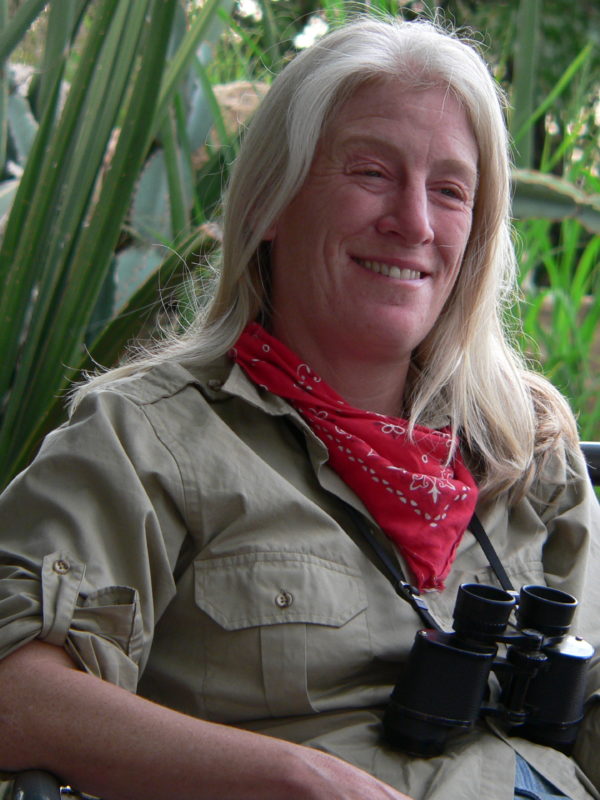
Blaire Van Valkenburgh
Distinguished Research Professor
Department of Ecology and Evolutionary Biology
Life Sciences Building 5312
Los Angeles, CA 90095
(310) 794-9398
bvanval@ucla.edu
Professor Blaire Van Valkenburgh holds the Donald R. Dickey Chair in Vertebrate Biology in the Department of Ecology and Evolutionary Biology at UCLA. She is currently the Curator of the Donald R. Dickey Collection of Birds and Mammals and Associate Dean of Academic Programs in the Division of Life Sciences. Dr. Van Valkenburgh received her Ph.D. in vertebrate paleobiology from the Johns Hopkins University in 1984. The focus of her over 110 publications is the biology and paleontology of carnivorous mammals, such as hyenas, wolves, and lions. She is an Honorary Fellow of the California Academy of Sciences and was elected a Fellow of the Paleontological Society in 2013. Dr. Van Valkenburgh has appeared in various television documentaries on prehistoric predators ranging from terror birds to sabertooth cats, and is a leading expert on the evolutionary biology of large carnivores, past and present.
Recent Courses
EEB 297 Foundations of Paleoecology
EEB 110 Vertebrate Morphology
Research Interests
As a vertebrate paleobiologist, my focus is the evolution of form, function and ecology in organisms, both living and extinct. I study living species as a key to understanding extinct species and am drawn to the fossil record because of its unique attributes. First, it provides the only record of long-term evolutionary change in form, matched perhaps in magnitude only by the history of genetic change preserved in the genome. Second, it provides a window into life and ecosystems prior to the alterations and biases engendered by anthropogenic forces and recent Pleistocene extinctions. Third, it presents us with species and morphologies that are no longer present, such as dinosaurs and sabertooth cats, and thereby expands our understanding of life?s potentials beyond what we can observe today.
Much of my research has focused on large predatory mammals. Large predators on land and sea are receiving much attention among ecologists because they act as major drivers within their ecosystems and many are threatened with extinction. As top-down regulators, they are pivotal players in trophic cascades that affect both plant and animal distributions and abundance. Modern species evolved within much more diverse and complex guilds of large predators that included species such as short-faced bears, sabertooth cats, and dire wolves. To better understand both the dynamics of extant predator communities and the adaptations of individual species, I have explored the fossil record of carnivores from both ecological and evolutionary perspectives, sometimes focusing on guilds of species in distinct time horizons, and other times focusing on the evolutionary trajectories of species over millions of years. Below I list four recent areas of research that exemplify the work in my lab.
1. Macroevolutionary dynamics of large carnivores
2. Evolution of mammalian feeding adaptations
3. Function and evolution of mammalian nasal turbinate bones
4. Molecular and morphological evolution within the Carnivora.
Selected Publications
Pang B, Van Valkenburgh B, Kitchell KF, Dickman A, and Marker L, “History of the cheetah-human relationship”, In: Cheetahs: Biology and Conservation, Marker L, Boast LK, Schmidt-Kuntzel A(Eds.), London Academic Press 359 : 17-24 (2018) .
Van Valkenburgh B, Pang B, Cherrin M, and Rook L, “The cheetah: evolutionary history and paleoecology”, Cheetahs: Biology and Conservation, Marker L, Boast LK, Schmidt-Kuntzel A(Eds.), London Academic Press 359 : 25-33 (2018) .
Balisi M, Casey C, and Van Valkenburgh B, “Dietary specialization is linked to reduced species durations in North American fossil canids”, Royal Society Open Science, Marker L, Boast LK, Schmidt-Kuntzel A(Eds.), 5 : 171861- (2018) [link].
Bird DJ, Murphy WJ, Rox-Rosales L, Hamid I, Eagle RA, and Van Valkenburgh B, “Olfaction written in bone: cribriform plate size parallels olfactory receptor gene repertoires in Mammalia”, Proceedings of the Royal Society B, Marker L, Boast LK, Schmidt-Kuntzel A(Eds.), 5 : – (2018) .
Curtis AA, Orke M, Tetradis S, and Van Valkenburgh B, “Diet-related differences in craniodental morphology between captive-reared and wild coyotes, Canis latrans (Carnivora: Canidae)”, Biological Journal of the Linnean Society, Marker L, Boast LK, Schmidt-Kuntzel A(Eds.), 123 : 677-693 (2018) .
Brown C, Balisi M, Shaw CA, and Van Valkenburgh B, “Skeletal trauma reflects hunting behavior in extinct sabre-tooth cats and dire wolves”, Nature Ecology and Evolution, Marker L, Boast LK, Schmidt-Kuntzel A(Eds.), 1 : 0131- (2017) .
Mann SA, Van Valkenburgh B, and Hayward MH, “Tooth fracture within the African carnivore guild: the influence of intraguild competition and resource availability”, Journal of Zoology, Marker L, Boast LK, Schmidt-Kuntzel A(Eds.), 303 : 261-269 (2017) .
Rygg AT, Van Valkenburgh B, and Craven BA, “The influence of sniffing on airflow and odorant deposition in the canine nasal cavity”, Chemical Senses, Marker L, Boast LK, Schmidt-Kuntzel A(Eds.), 42 : 683-698 (2017) .
Ripple, W.J., Chapron, G., Lopez-Bao, J.V., Durant, S.M., Macdonald, D.W., Lindsey, P.A.,Bennett, E.L., Beschta, R.L., Bruskotter, J.T., Campos-Arceiz, A., Corlett, R.T., Darimont, C.T., Dickman, A.J., Dirzo, R., Dublin, H.T., Estes, J.A., Everatt, K.T., Galetti, M., Goswami, V.R., Hayward, M.W., Hedges, S., Hoffmann, M., Hunter, L.T.B., Kerley, G.I.H., Letnic, M., Levi, T., Maisels, F., Morrison, J.C., Nelson, M.P., Newsome, T.M., Painter, L., Pringle, R.M., Sandom, C.J., Terborgh, J., Treves,, “Conserving the world’s megafauna: the fierce urgency of now”, BioScience, Marker L, Boast LK, Schmidt-Kuntzel A(Eds.), 67 : 197-200 (2017) .
